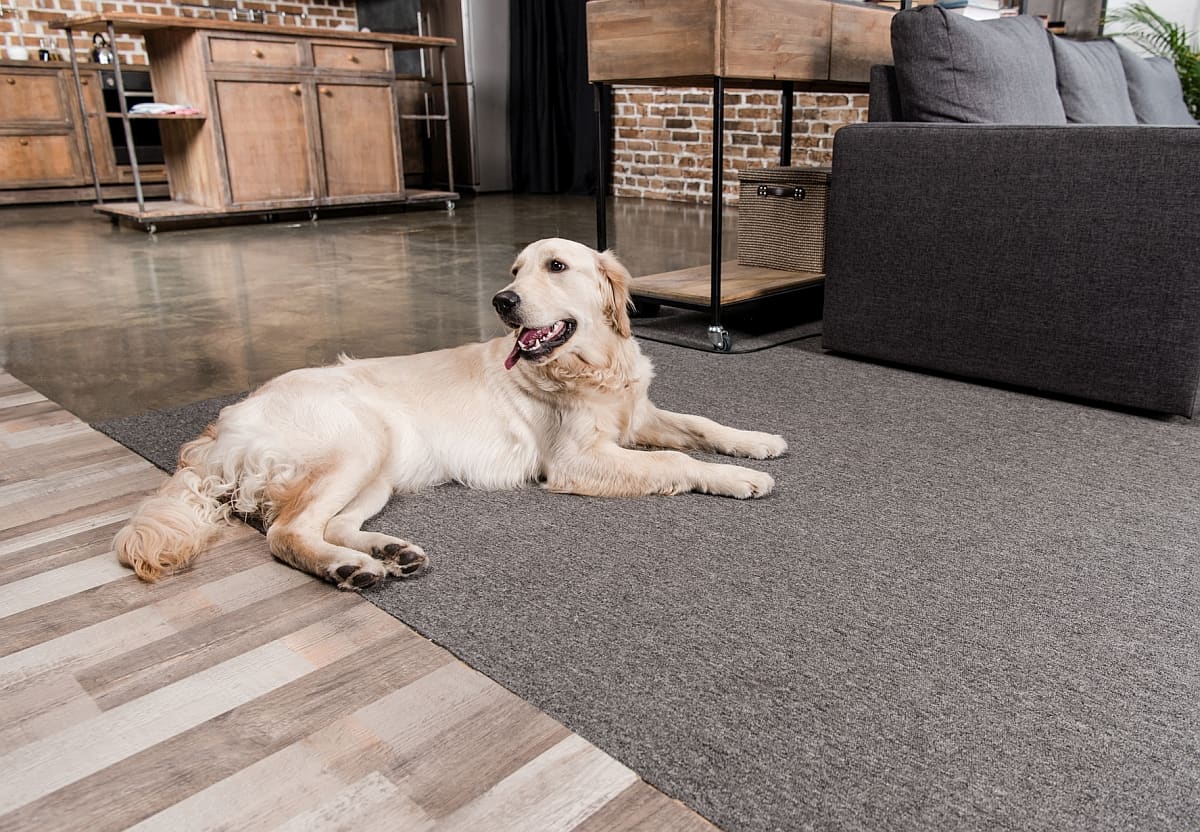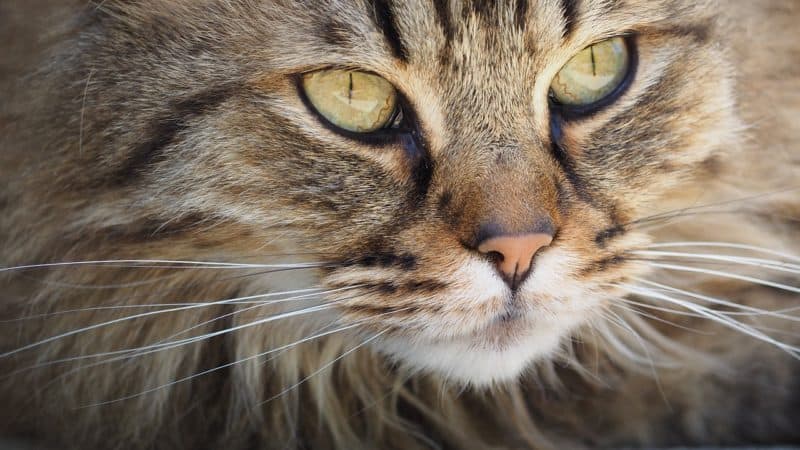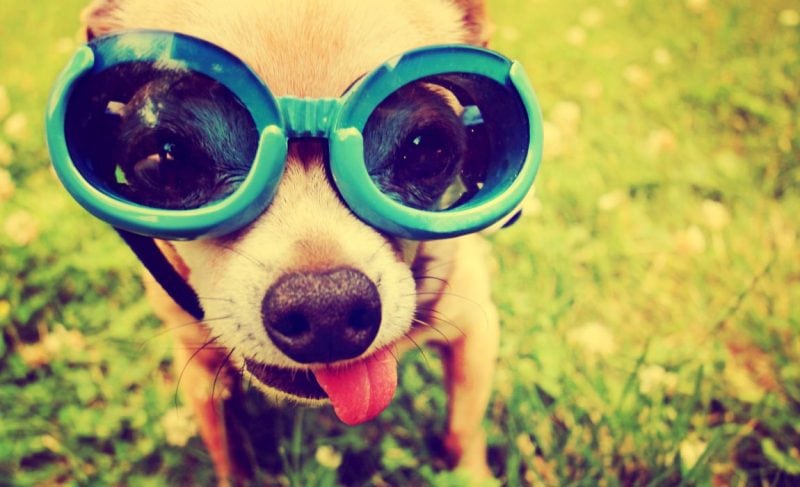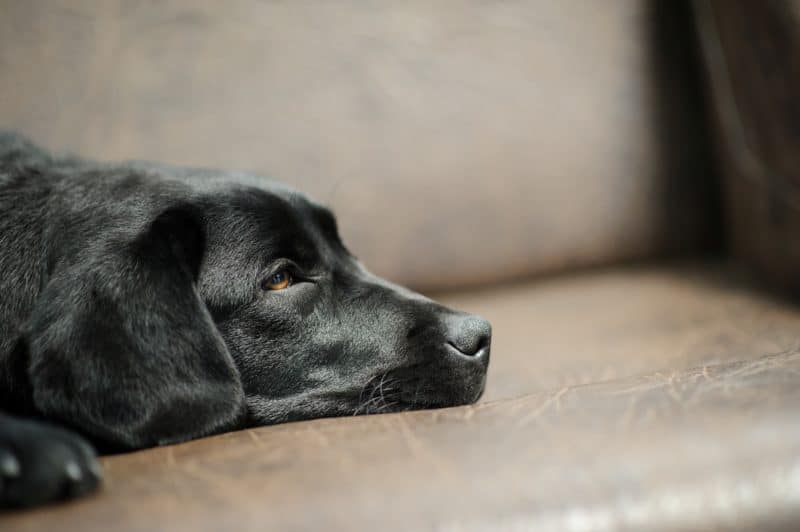You can often tell whether or not a dog lives in a home just by looking at the floor.
Do scratches and scuffs stretch between the front door, kitchen and couch? That’s the dog’s route to and from his favorite haunts.
Are there oval-shaped areas of discoloration by the windows and door? That’s where the dog spends most of his time resting and sleeping.
Can you see a dark, circular stain or two on the carpet? The one on the left is from a potty-accident last year; the one on the right occurred when he barfed a few months ago.
So, yeah, it is pretty obvious a dog lives here.
Canine Considerations: What Qualities Do You Want in a Pet-Proof Floor?
Dogs are very hard on floors, and they can quickly ruin those that are not resilient and durable enough to withstand the damage they can inflict.
Different types of floors will handle these problems to varying degrees, so it is always important that pet owners think carefully when considering flooring options.
To pick a good flooring for dogs (and the general household), you must understand the kinds of things you want to look for when making your choice. Some of the most important considerations include:
You want a floor that won’t become scratched by your dog’s toenails. Your beloved pooch walks around with 16 rock-hard and often sharp claws, which will scrape your floor day and night for the rest of his life. Declawing your dog isn’t an option, and while keeping your dogs nails short can help, it won’t completely eliminate scratches that come as a result of life with a dog. Unless you are interested in refinishing or replacing your floors every few years (or you like the “weathered look”), you’ll want to pick one made from an extremely durable material.
You should pick a floor that won’t retain odors. Even the most reliable and housebroken pooch is sure to have the occasional accident. If urine seeps into your flooring, your entire house can start to smell bad. While pet-safe floor cleaners are always an option for helping to eliminate odor, ideally you’ll be best off starting with a flooring material that is less porous and won’t retain odors.
You have to keep your dog’s traction needs in mind. It can occasionally be difficult for dogs – particularly those of advanced age or suffering from hip, joint or leg problems – to get a good grip on super-slippery floors. If your dog fits these criteria, you’ll want to make sure to emphasize traction when making your decision.
Best Flooring For Dog Households
While there are probably a few incredibly pet-proof flooring options available to the rich and the famous, most mortals will find that they’ve got six basic options.
Each one has its own pros and cons, so be sure to consider your specific circumstances before making your choice.
Option #1: Hardwoods
At first glance, hardwood floors seem like a pretty good option for homes with pets, and in many ways, they are. For example, hardwood floors are easy to sweep, which is nice for homes with heavy shedders. Liquids won’t soak into a hardwood floor as quickly as they will a carpet, either. But hardwood floors do present a few problems, and they aren’t always the best choice for pet owners.
For starters, while it is true that liquids won’t soak into a hardwood as quickly as they will carpet, they will eventually seep in and leave stains. This means you still have to clean up any accidents within a few minutes – hardly a good solution for homes with pee-pee bandits.
Additionally, claws can scratch many wooden floors. As long as you pick one of the hardest woods – Brazilian rosewood, Bolivian cherry, and Tigerwood are all good choices – available, this won’t be a big problem, but many of these options are expensive and difficult to find.
Hard maple, white oak, and beech are a little more affordable, and they’ll have a reasonable chance of weathering your dog’s claws. Note that some “hardwood” floors are not made from hardwoods at all. Pine, for example, is actually a soft wood, which is unlikely to last very long when exposed to your pet’s claws.
It is worth noting that woods with a distinct grain pattern tend to de-emphasize minor imperfections better than a those with very subtle patterns. It is also important to coat hardwood floors in a strong sealant to help protect it from both scratches and liquids.
Option #2: Carpets
Capet is certainly a popular floor material, and it offers a number of key benefits. Carpet flooring is warmer than smooth floors are and provides more cushioning too. It hides small amounts of dust well, and it is fairly easy to clean with a vacuum.
However, carpet also has some very significant downsides for pet owners.
Take, for example, the absorbent nature of carpet (and any padding beneath it). Because carpet will quickly soak up most fluids, it will easily become stained and retain odors. This can quickly ruin the aesthetics of your carpet and cause your home to smell horrible.
Luckily, there are some great carpet cleaners for dog urine out there, but it still might be smart to limit your risk exposure by opting for a few rugs over some harder-surface floors rather than wall to wall carpeting.
The video below offers a few suggestions on getting smelly urine out of your carpet!
There are a few fancy carpets and treatment technologies that can help mitigate these problems, but they will offset one of the biggest benefits of carpet: its affordable price.
Carpet tiles present an intriguing alternative in some cases, as they can be replaced individually, which means that an accident won’t end up costing you a fortune to repair.
Give special consideration to the type of pile (which refers to the way in which the threads are attached to the carpet) the carpet features. “Cut pile” carpets are essentially comprised of single carpet fibers, which stick straight up from the backing material. “Loop pile” carpets, by contrast, are comprised of tiny loops.
Loop pile carpets are not necessarily problematic, just be sure to avoid any that are large enough to snag your pet’s claws.
Some carpets and rugs are better for dog households than others, with easier-to-clean carpets being ideal. Many owners also opt for non-toxic materials, especially for dogs that won’t stop licking the carpet.
Option #3: Bamboo
Over the last decade or so, bamboo has become a popular flooring material. Once you look at the characteristics of the material, it is easy to see why.
First of all, bamboo is very durable. It won’t become scratched or discolored easily, and while bamboo isn’t really a tree (it’s a type of woody grass), it is harder than many of the woods used in hardwood floors.
Bamboo resists stains pretty well, and it won’t absorb liquids especially quickly. It is also a very attractive flooring material that provides homes with a unique look.
But perhaps most importantly, bamboo is an eco-friendly material that can be harvested without destroying wild habitats.
It takes decades for an oak or maple tree to grow large enough to be appropriate for milling, but you can just about pull up a chair and watch bamboo grow – it is actually regarded as
The primary downside to bamboo is its cost – it is a pretty pricey dog flooring option. However, as the material becomes more popular, economies of scale should help bring down the price point significantly. So, even if you can’t afford to install bamboo floors today, you should probably keep it on your radar.
Option #4: Stone Tile
Stone tiles are remarkably resilient, and most varieties will stand up to your dog’s claws for years. However, you’ll want to avoid some of the softest and most porous materials (such as marble and slate), as these may suffer from some damage over time.
Granite is one of the most durable options and is a great choice for most pet owners. Most tiles are non-porous, and therefore completely waterproof, so spills and accidents aren’t a big problem.
Stone tiles are not terribly comfortable for your dog, but as long as you provide him with a soft bed to lay on, this shouldn’t be a big problem. Some stone tiles are quite slick, so you may want to avoid them with older pets, who often have trouble negotiating slippery floors.
Note that stone tiles can change temperatures quite significantly. They’ll heat up if they are close to a fireplace or near a window in direct sunlight, and they’ll tend to get pretty chilly during the winter. This shouldn’t cause too many problems for your pup, but be mindful of the possibility.
Option #5: Laminates
Laminate floors usually look like hardwood floors (although they can also be made to look like stone or other materials), but they are engineered wood products, instead of wooden planks. They are created by attaching an image-bearing paper surface to a piece of fiberboard, which is then installed on your floor.
Laminates are pretty good choices for homes with pets, as they are fairly scratch resistant and they don’t readily absorb fluids. They can often be purchased with varying levels of abrasion resistance, and different individual products are available in a range of gloss levels from which you can choose.
Laminate floors won’t last quite as long as true hardwoods, but they are still a good long-term flooring solution.
The biggest potential problem with laminates is that they are often slippery. If this is a problem for your pet, be sure to select a laminate that has some texture to it to give your pup a little more traction. As when selecting any type of flooring option, try to select a color that won’t contrast too sharply with your dog’s hair color to keep your floors looking cleaner.
Option #6: Vinyl
Vinyl is relatively resistant to pet claws, and it provides pets with a better grip than many other smooth flooring options. Vinyl won’t become stained very easily, and accidents can be quickly and easily cleaned when need be.
Although some owners may prefer the look of hardwoods, carpet or some other floor treatment, vinyl is a pretty good-looking floor option, which is available in an array of colors and patterns.
It is important to keep vinyl floors relatively dry, as they can mildew or begin lifting if they are allowed to remain wet. And while vinyl floors aren’t likely to become scratched by your pet’s claws, they rarely retain their high sheen for very long.
Vinyl also provides one more benefit: It is a quiet flooring material, which will dampen the sound of your dog’s nails clicking on the floor.
Check out this handy infographic from Floor Authority for additional info about the best pet-friendly flooring options available:

Floor Care Tips & Tricks for Dog Owners
No matter what kind of floor material you choose, you’ll want to do everything possible to keep it looking and smelling new for years to come. Fortunately, there are a number of things you can do to protect your floors and effectively clean up the occasional mess.
- Clean your pet’s feet before letting them come inside. You can just use a damp rag if you like, but there are a number of paw washers on the market that will work even better.
- Keep your dog’s nails trimmed. This isn’t only important for your dog’s health (improperly trimmed nails can lead to osteoarthritis and other joint problems), but it will help keep your floors looking better too. Check out our nail-trimming guide to learn the correct way to clip your dog’s nails.
- Bathe your dog regularly. The dirt and debris coating your dog will end up all over your floor, making it look dirty and smell terrible, so you want to make sure you keep your dog as clean as possible (just don’t over-do it; most dogs only need a bath once a month or so).
- Brush your dog off outside to help reduce the amount of shed hair that ends up on the floor. Shed hair will make your floor look dirty and it also carries dander and saliva proteins with it, which can make life miserable for allergy sufferers. Fortunately, most dogs love being brushed, and if you just make a habit of brushing him off before coming inside, you’ll keep most of the hair off the floor.
- Have a good odor neutralizer on hand to deal with accidents. While poop smells horrible initially, it won’t usually cause lingering odors after you clean it up. Urine, on the other hand, is another matter entirely. Urine can soak into wood or carpet fibers and lead to odors that last for years. Accordingly, you’ll always want to clean up messes quickly and use a good odor neutralizer (just be sure to test the neutralizer in an inconspicuous spot first to make sure it won’t discolor your floors).
- Take the time to properly housetrain your dog. It can be frustrating to house train your dog, and some breeds are particularly difficult to train in this regard, but your floors will thank you. Check out our guide to housebreaking if you need a little help with the process.
- Use protective mats under your dog’s flood and water bowls. Dogs are messy eaters and drinkers, and the food and water that they spray around the food dish can ruin your floor. Silicone feeding mats are an easy and affordable way to help protect the area around your dog’s food and water bowl.
What kind of flooring do you use in your home? Has it held up to your dog’s nails? What about the occasional accident? Have you had a particularly bad experience with anything (I could tell you some stories about ruined carpets…)? Tell us all about it in the comments below!








Leave a Comment